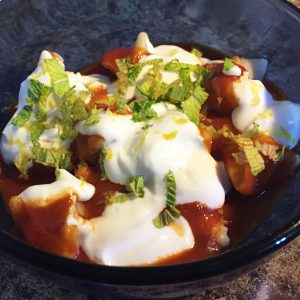The Middle East on a flatbread: Turkish meatballs, a tahini-spiked yogurt sauce, and muhammara, a Syrian red pepper spread.
Print Recipe
Lam Köfte with Yogurt Sauce and Muhammar
Votes: 0
Rating: 0
You:
Rate this recipe!
|
|
Votes: 0
Rating: 0
You:
Rate this recipe!
|
Instructions
For yogurt sauce: Stir all ingredients in medium bowl to blend. Cover and chill.
For Köfte: Line large rimmed baking sheet with plastic wrap. Gently mix lamb and next 8 ingredients in large bowl. Using moistened hands and scant 2 tablespoonfuls for each, roll meat mixture into 1 1/2-inch meatballs. Arrange on sheet.
Preheat oven to 300°F. Place large sheet of foil on work surface. Heat large nonstick or cast-iron skillet over medium-high heat. Add flatbreads to skillet 1 at a time; cook until browned, about 2 minutes per side. Enclose in foil; place in oven to keep warm.
Heat 1 tablespoon oil in same skillet over medium-high heat. Add onions; sprinkle lightly with salt and pepper. Sauté until golden brown, about 8 minutes.
Transfer onions to 1 side of large rimmed baking sheet; place in oven to keep warm.
Add 1 tablespoon oil to same skillet; heat over medium-high heat. Sauté half of meatballs until just cooked through, 7 to 8 minutes. Transfer to baking sheet in oven. Repeat with remaining meatballs, adding oil to skillet if dry. Reserve skillet.
For muhammara: Add roasted peppers to reserved skillet; stir 1 minute. Add 1/2 cup water and 2 tablespoons pomegranate molasses. Bring to simmer, scraping up browned bits. Cook until reduced to 2/3 cup, stirring occasionally, about 4 minutes. Mix in parsley. Season to taste with salt, pepper, and more pomegranate molasses, if desired. Transfer to small bowl.
Arrange onions and meatballs on platter. Serve with warm breads, yogurt sauce, and muhammara.


